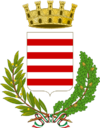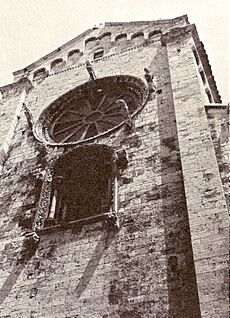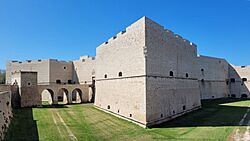Barletta facts for kids
Quick facts for kids
Barletta
|
|||
|---|---|---|---|
| Comune di Barletta | |||
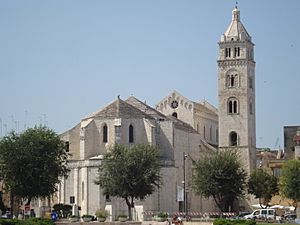
View of the cathedral.
|
|||
|
|||
| Country | Italy | ||
| Region | Apulia | ||
| Province | Barletta-Andria-Trani (BT) | ||
| Frazioni | Montaltino, Fiumara, Canne della Battaglia | ||
| Area | |||
| • Total | 149.35 km2 (57.66 sq mi) | ||
| Elevation | 15 m (49 ft) | ||
| Population
(31 December 2017)
|
|||
| • Total | 94,477 | ||
| • Density | 632.588/km2 (1,638.40/sq mi) | ||
| Demonym(s) | Barlettani | ||
| Time zone | UTC+1 (CET) | ||
| • Summer (DST) | UTC+2 (CEST) | ||
| Postal code |
76121
|
||
| Dialing code | 0883 | ||
| Patron saint | St. Roger of Cannae, SS. Madonna dello Sterpeto | ||
| Saint day | December 30 | ||
Barletta is a city in Apulia, a region in southeastern Italy. It is one of the main cities in the Province of Barletta-Andria-Trani, along with Andria and Trani. About 94,700 people live in Barletta.
The city is located near the Ofanto river, which flows through the countryside. This river forms a natural border between Barletta and Margherita di Savoia. The river's mouth, where it meets the sea, is also in Barletta's territory.
Barletta's area includes part of Cannae, a very important historical site. This place is famous for a huge battle in 216 BCE. In this battle, the Romans fought against the Carthaginians, led by Hannibal. Hannibal's army won this famous battle. Cannae was recognized as a "City of Art" in 2005 because of its beautiful old buildings.
Barletta is home to the amazing Colossus of Barletta. This is a huge bronze statue of a Roman Emperor, possibly Theodosius II. Locals call it "Eraclio." It stands about 4 meters (13 feet) tall. It is the largest statue from the late Roman Empire that still exists today. A local story says Eraclio once saved the city from an attack.
In 1503, Barletta was the setting for the disfida di Barletta, or "Joust of Barletta." This was a famous battle where 13 Italian knights, led by Ettore Fieramosca, fought against 13 French knights. The Italian knights won this joust, which took place near Andria. This event is seen as an early example of Italian national pride.
During World War II, Barletta showed great bravery. The city resisted German paratroopers who tried to destroy its port. This act of courage earned Barletta two gold medals for military and civil bravery.
Contents
Where is Barletta?
Barletta is on the Adriatic coast of Italy. The coastline here is a mix of rocky areas and silt from the Ofanto river. This river is important for farming in the area. It also marks the change from the Murgia hills to the flat, fertile plain called Tavoliere.
The city is located at the southwest end of the Gulf of Manfredonia. It faces the Gargano Promontory. Nearby towns include Trani (12 km or 7.5 miles southeast) and Margherita di Savoia (13 km or 8 miles west). Barletta is on a low plain, only about 10 to 15 meters (33 to 49 feet) above sea level.
The sea helps keep Barletta's weather mild. Winds usually come from the south. The city does not get much rain, about 500 mm (20 inches) each year. Most rain falls in autumn and winter. Summers, especially from late June to early August, are very dry.
Barletta has a long, sandy coastline with nice beaches. You can find many attractive beaches with trees to the west of the commercial port.
Barletta's Past
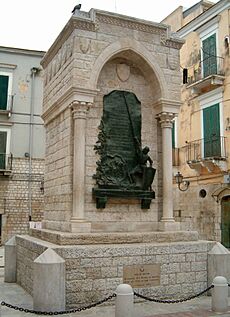
Barletta existed long before the Roman times. The ancient Greeks and Romans knew it as Bardulos or Barulum.
In the Middle Ages, Barletta was a strong base for the Normans and Lombards. It became an important stop for Crusaders traveling to the Holy Land. It also hosted the Teutonic Knights, Templars, and Knights of St.John.
Barletta grew a lot when people from nearby Cannae moved there after their town was destroyed. The city had its best times under King Frederick II and later the Angevin kings.
In the early 1500s, during a war between France and Spain, the famous Challenge of Barletta took place. This event, where Italian knights defeated French knights, happened while Spanish forces occupied the city. Barletta then became an important fortress for the Spanish rulers of southern Italy.
The city was a local capital for many years, from 1806 to 1927. It supported the French leader Joachim Murat during the Napoleonic Wars.
After Italian unification, Barletta, like much of southern Italy, faced challenges. During World War I, a small naval battle happened off Barletta's coast. In World War II, Barletta was the site of the first conflict between Italian and German troops. The Italian soldiers bravely defended the port against German paratroopers.
Famous Places to See
Here are some of the main sights in Barletta:
- The Castle: This castle was first built around the 10th century by the Normans. During the Crusades, it was a place for soldiers going to the Holy Land to stay. Frederick II made it much bigger between 1225 and 1228. Later, Charles V added four large towers, giving it its current strong look.
- Colossus of Barletta: This is the huge bronze statue of a Roman Emperor we talked about earlier.
- Basilica of the Holy Sepulchre: This church was built in the 12th century. It used to be the main office for the Knights of Malta outside the city walls. It has a Romanesque style with some influences from Jerusalem.
- Cathedral of Santa Maria Maggiore: This cathedral is a mix of Gothic and Roman styles. It was built on the site of an old temple. Inside, you can see very old tombs from the 3rd century BC and parts of even older churches.
- San Giacomo: This 11th-century church was built where a Roman temple once stood. It was rebuilt after an earthquake in 1751.
- The Cellar of the Challenge: This was once a prison for galley slaves.
- Palace of the Marra: A beautiful Baroque palace that now holds the Giuseppe De Nittis art gallery.
- Canne della Battaglia: This is an important archaeological site, famous as the location of the ancient Battle of Cannae.
People of Barletta
| Historical population | |||||||||||||||||||||||||||||||||||||||||||||||||||||||
|---|---|---|---|---|---|---|---|---|---|---|---|---|---|---|---|---|---|---|---|---|---|---|---|---|---|---|---|---|---|---|---|---|---|---|---|---|---|---|---|---|---|---|---|---|---|---|---|---|---|---|---|---|---|---|---|
|
|
||||||||||||||||||||||||||||||||||||||||||||||||||||||
| Source: ISTAT | |||||||||||||||||||||||||||||||||||||||||||||||||||||||
Barletta has a population of about 94,700 people. The chart above shows how the population has changed over the years.
What Barletta Does
Barletta's economy mainly relies on making concrete and cement. Farming is also important, with grapes and olives being the most common crops grown in the area.
Getting Around Barletta
You can reach Barletta by train using the Adriatic Railway or the Bari–Barletta railway. There is also a train line from Barletta to Spinazzola.
If you travel by car, you can use the A14 motorway or the SS16 highway. The nearest airport is Bari-Palese, which is about 55 km (34 miles) from Barletta.
Barletta has a commercial port with the Barletta Lighthouse. While there are no direct sea connections from Barletta, you can find ferry services to other places from nearby cities like Bari.
Sister Cities
Barletta has one twin town:
Famous People from Barletta
- Roger of Cannae (1060–1121): A saint and bishop, he is a patron saint of Barletta.
- Ettore Fieramosca (1476–1515): He led the Italian knights in the famous Joust of Barletta.
- Giuseppe De Nittis (1846–84): A well-known impressionist painter.
- Carlo Maria Giulini (1914–2005): A famous orchestra director.
- Pietro Mennea (1952–2013): A world-record holder in the 200-meter sprint and an Olympic gold medalist.
- Francesco Lotoro (1964-): A composer and archivist of Holocaust music.
Images for kids
See also
 In Spanish: Barletta para niños
In Spanish: Barletta para niños



